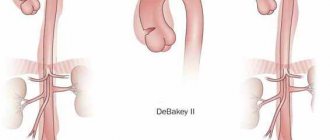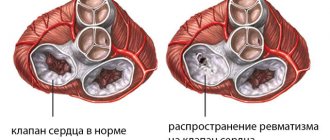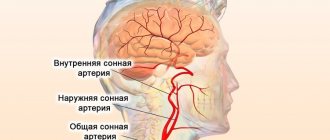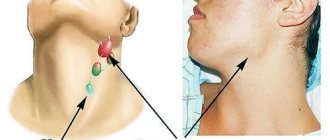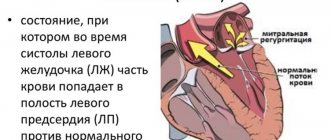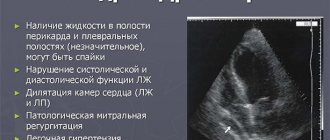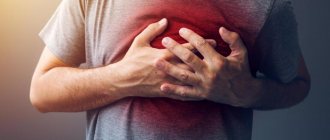Atherosclerotic heart disease is a pathology affecting the coronary arteries.
During the process, narrowing (stenosis) or blockage of blood vessels with cholesterol plaques, less often blood clots, is observed, which is much more dangerous and causes a heart attack and sudden death.
Diagnosis is carried out under the supervision of a cardiologist within a short period of time.
The recovery period is long, it takes at least 3 months to eliminate the underlying condition, followed by maintenance therapy of uncertain duration.
The mechanism of pathology development
Becoming does not happen overnight. As already mentioned, Atherosclerosis of the heart is a narrowing or stenosis of the coronary arteries.
The condition turns out to be the result of thromboembolism; this is the only exception to the rule, when the phenomenon is acute and requires immediate care in a hospital.
Much more often as a result of metabolic processes. The exchange of lipid structures or mineral salts is disrupted.
The consequence of such a deviation is the deposition of cholesterol on the walls of blood vessels, then the growth of plaques (they almost never resolve on their own).
The next stage is calcification or salt deposition on the walls of fatty formations.
As the process progresses, a narrowing of the lumen of one or another coronary artery is observed. The narrower it is, the worse the hemodynamics - the nutrition of all organs and systems is disrupted, and generalized dysfunctions occur.
Treatment is carried out as planned. But it is better to start it earlier; complications and aggravation of the main phenomenon are possible, when surgery cannot be avoided.
Causes of death in atherosclerosis
Among them are the following:
- Coronary atherosclerosis. Sudden death with this complication is a common occurrence, since prolonged myocardial ischemia leads to gradual decompensation of cardiomyocytes and the occurrence of necrosis in them.
- Acute cerebrovascular accident. Briefly referred to as “stroke”. The complication is the most common cause of death in elderly patients.
- Pulmonary embolism.
- Obliterating endarteritis with a risk of thrombus rupture.
Acute stroke
If the blood circulation in the brain is impaired, a pathology such as a stroke, which is characterized by facial asymmetry, may appear.
This is a sudden ischemia of the cerebral cortex. It is accompanied by symptoms such as a sudden headache, which increases and is poorly relieved by non-steroidal anti-inflammatory drugs. Patients experience asymmetry of the facial muscles, anisocoria and partial paralysis of the limbs. Survival from stroke depends on timely assistance and concomitant diseases.
Acute myocardial infarction
This medical term refers to death from atherosclerosis of the heart. When plaques formed from triglycerides, cholesterol molecules, low or very low density lipid fractions appear and grow on the walls of the coronary arteries, this prevents adequate blood supply to the myocardium. The heart muscle becomes necrotic in places where cardiomyocytes begin to experience oxygen starvation. This ends in myocardial infarction. Mortality depends on the extent of the infarction and the degree of general decompensation of the patient's condition.
Pulmonary embolism
Occurs when a detached cholesterol plaque enters the pulmonary vessels through the systemic and pulmonary circulation. In this case, partial or total death of alveolocytes—the structural elements of lung tissue—occurs. Edema develops in the lungs with accumulation of exudate. The patient develops hemoptysis, severe shortness of breath and increasing cyanosis. In this case, instant death rarely occurs, more often within a day.
Types of atherosclerosis
Variants of the pathological process are determined by several criteria. Depending on the essence of the change, they are called:
- Narrowing or stenosis of a blood vessel. Rarely encountered in clinical practice. The formation of this type of atherosclerotic disease is the result of long-term and active smoking, alcohol addiction, taking cocaine or heroin of dubious quality (that is, any). Recovery appears difficult, requiring mandatory surgery such as stenting.
- Occlusion, also known as blockage of blood structures. Observed in 70% of situations. It is determined by the deposition of lipid substances and cholesterol on the walls of blood vessels. Hemodynamics are disturbed gradually. As a rule, atherosclerosis of the coronary arteries begins at a young age. It makes itself known after at least 5-10 years; if the lifestyle is extremely unfavorable, then perhaps earlier.
Surgical intervention
If drug therapy is not able to stop the progression of atherosclerotic heart disease and does not relieve the symptoms of impaired coronary blood supply to the cardiac myocardium, then surgical treatment of this pathology is used:
- Angioplasty method and stenting method. During a minimally invasive operation, a catheter is inserted into the coronary vessel, through which a special stand (balloon) is inserted into the site where the artery is damaged by atherosclerosis. This inserted balloon allows the atherosclerotic plaque to be pressed against the arterial lining, allowing the arterial lumen to increase. Also, to constantly maintain the normal lumen of the coronary artery, a stand, which has the shape of a metal mesh pipe, is placed in place of the atherosclerotic plaque;
- Method of bypass grafting of coronary arteries. This is the most used method for the treatment of coronary insufficiency and atherosclerotic heart disease. This is an open operation on the heart organ, when a bypass path for blood flow is created on the coronary arteries, bypassing the atherosclerotic plaque.
Angioplasty method
Four stages of development
Another basis for classification is the staged nature of the process. Accordingly, they distinguish:
- Stage 1. Easy. Occurs in early years. Characterized by a complete absence of symptoms. The volume of overlap of the artery lumen is up to 15%, compensatory mechanisms still level the position completely. Treatment is conservative, recovery is short.
- Stage 2. Moderate. The amount of overlap is 25% or so, no more. The symptoms are minimal, but already present. From the heart, blood vessels and lungs. Less common cerebral structures. The treatment is carried out under the supervision of a group of specialists, there is still a chance of full recovery.
- Stage 3. Expressed. Accompanied by blocking of the blood vessel by almost half. Hemodynamics are significantly disrupted. Cardiac manifestations predominate; cerebral manifestations occur equally with them. The treatment is surgical, but there is no need to wait for a complete recovery: there are organic disturbances in the anatomical structures.
- Stage 4. Terminal. At least 10-15 years pass before its onset, sometimes more. In order not to notice the worsening of the process, you need to try hard, because the likelihood of such a scenario is minimal. Multiple organic disorders and anatomical defects leave no chance for a long life. Palliative care.
Forms of cardiac atherosclerosis: acute and chronic. The second one is better controlled.
Stages
Atherosclerotic heart disease develops gradually and rather slowly. The process of formation of lipid deposits is usually divided into 5 successive stages.
- Stage 1 – pre-lipid stage. Due to an increase in LDL content in the blood, the speed of blood flow decreases. Microcracks appear on the vascular walls.
- Stage 2 – lipoidosis. In the area of violation of the integrity of blood vessels, lipid cells begin to be deposited, which increase in size over time.
- Stage 3 – liposclerosis. Young connective tissue is formed in areas of fatty formations. Its further maturation is accompanied by the appearance of a fibrous plaque. At this stage, the pathology responds very well to conservative therapy.
- Stage 4 – atheromatosis. At this stage, the breakdown of protein and lipid accumulations, collagen and elastic fibers occurs. Due to the crystallization of cholesterol and fatty acids, the walls of blood vessels are deformed. Such changes cause various complications: when the integrity of the surface of the cholesterol plaque is damaged through the bloodstream, atheromatous masses are washed out and form ebola; with necrosis (death) of the deep layers of the vascular walls, an aneurysm is often formed and there is a high probability of its dissection or rupture.
- Stage 5 – atherocalcinosis. The final stage of the development of the disease, in which deposits of calcium salts accumulate in the atherosclerotic plaque. The formation acquires a rocky density, and the vessel wall in the area of petrification (calcification) is deformed. As a result of these changes, the likelihood of thrombosis increases significantly.
Causes
Factors in the development of the pathological process are multiple and always have a pathogenic, cardiac nature.
Many can be adjusted by the patient himself. They are subjective, controlled.
- Tobacco smoking. The most common cause of stenosis of the coronary arteries. The duration of development of anatomical defects is about 3-5 years. Then organic changes in the blood vessels are formed. Hence, circulatory failure at the local level. And this is the path to a heart attack and seizures. If you have a serious history of tobacco consumption, quitting the bad habit is not enough. Long-term treatment, diet, and radical lifestyle changes are required.
- Burdened heredity. Family history plays the greatest role in the development of the pathological process. If there was at least one person in the family who suffered from atherosclerosis of the coronary arteries, the likelihood of the pathology manifesting itself in the phenotype increases by 30-40%, if both parents or two family members - even higher. This factor cannot be controlled, but as part of prevention, risks can be reduced to a minimum, although not completely zero. This is the main reason for the development of the disease in young people.
- Stable arterial hypertension. Especially at stages 2-3, when the tonometer readings no longer decrease on their own. The essence of the process is the increased load on the cardiac structures. Hence the constant narrowing of the coronary arteries, the impossibility of an adequate blood supply. A vicious circle arises. Treatment is conservative. In case of significant stenosis, surgical intervention is required.
- Obesity. Actually, this is not a development factor, but rather an indication of origin. All patients with increased body weight have metabolic syndromes. They manifest themselves in particular as disorders of lipid metabolism. Cholesterol plaques are deposited on the walls of blood vessels. Blood pressure rises. Thus, a complex of causes for the development of atherosclerotic heart disease arises. Everything needs to be eliminated, otherwise the effect will be incomplete.
- Cholesterolemia. Increased blood lipid levels. This is not an independent pathology, but rather a symptom of a process. It does not require treatment in itself; the main phenomenon is eliminated. Statins are used as part of therapy. They are dangerous if used unsupervised; a doctor's prescription is required.
- History of diabetes mellitus. Generalized dysfunction of the body. It cannot be completely eliminated, you can only keep the pathology under control, preventing it from moving forward in development. Heart problems are the number one complication of diabetes. For your information, the main cause of death for patients is heart attack. Slightly less common are gangrene and sepsis against the background of specific obliterating atherosclerosis of the lower extremities.
- Physical inactivity. Lack of physical activity. Patients with a sedentary lifestyle are at greater risk; this is often a professional characteristic. Also bedridden patients of any age. To prevent blood stagnation and metabolic disorders, it is recommended to walk 1-2 hours a day.
- Poor nutrition. Diet errors play a huge role in the development of changes in the cardiovascular system. We can easily eliminate the factor on our own. Restoring after menu correction is not difficult.
- Peak hormonal states such as puberty, pregnancy, menopause and menopause in both sexes.
The reasons for the development of pathology are varied, and recovery presents certain difficulties. If therapy is ineffective, progressive atherosclerosis of the heart occurs.
Causes of development, risk factors
Atherosclerosis develops over a long period of time, so the pathology is based on many provoking factors. The main reasons for the formation of atherosclerotic heart disease include:
- high blood pressure;
- hypercholesterolemia, hyperglycemia;
- diabetes mellitus type 2;
- bad habits (alcohol, smoking, drugs, abuse of coffee, sweet soda);
- genetic predisposition;
- liver dysfunction;
- infections;
- exacerbation of somatic pathologies associated with the condition of blood vessels.
Provoking factors are considered:
- age;
- floor;
- obesity;
- excessive consumption of fats in food;
- stressful situations;
- physical inactivity;
- diet with insufficient fiber.
Symptoms
Changes of this kind are represented by two clinical variants.
The process itself does not give any picture; it is determined by manifestations of a specific type. Heart attack or angina pectoris are the main diagnoses.
Among the manifestations:
- Chest pain of unknown origin. Pressing, pulling. They radiate to the left arm, back, shoulder blade. It proceeds in fits and starts. Each episode lasts from 5 to 50 minutes or a little more.
- Arrhythmia. Usually by type of acceleration of cardiac activity. The reverse process or a change in the intervals between each subsequent contraction is possible. Dangerous and relatively harmless species are identified. Group extrasystole, fibrillation, and paroxysmal tachycardia pose a threat to life and health. A change in heart rate can be considered an independent clinical variant with typical symptoms: a feeling of a sinking heart, a sharp jolt in the chest, an irregular beating.
- Dyspnea. In the initial period, against the background of intense physical activity. This is a classic situation, which, however, is difficult to identify. Only within the framework of special tests. Against the background of the deviation, oxygen saturation decreases. Later it occurs as a result of minor activity or in a state of complete rest.
- Disturbances of consciousness such as lethargy, problems with thinking, fog in the head.
- Fainting. Syncope occurs spontaneously, without a preliminary period. Multiple episodes may occur within the same day. Falls and injuries pose a danger.
- Panic attack. Characterized by fear, uncontrollable anxiety. The use of sedatives is required to relieve the condition. At such a moment, a person is inadequate, dangerous actions are possible.
- Vertigo. Dizziness. Up to the inability to stand on your feet and navigate in space.
- Cephalgia (headache). Medium intensity. Treated with standard analgesics, but occurs again.
Caution:
There may also be signs of medical emergencies such as stroke. In such a situation, inhibition, impaired thinking, weakening of vision, hearing, tactile sensations, speech, and other higher functions appear.
Symptoms of atherosclerosis of the heart vessels are multiple, but nonspecific. It is impossible to diagnose them alone; it is a waste of energy.
Symptoms of pathology
Atherosclerotic heart disease is characterized by arrhythmia, angina and heart failure. The course of the disease is usually chronic and asymptomatic. But if the pathology worsens for any reason, then the following clinical manifestations are observed:
- retrosternal discomfort, heart pain radiating to the neck, arm, lower jaw, stomach or back;
- pre-fainting after a stressful situation;
- panic attacks;
- shortness of breath even at rest, cough;
- COPD, cor pulmonale;
- weakness, weakness, headache, feeling of anxiety;
- lack of appetite;
- Pasty ankles are a symptom of heart failure;
- lump in throat;
- hypertension;
- arrhythmia, which may be accompanied by fainting;
- angina pectoris - begins after physical activity, stress, lasts about 10 minutes, goes away after rest, taking nitroglycerin tablets;
- limbs become numb and cold to the touch;
- libido fades, erectile function decreases;
- intermittent claudication appears after nervous strain;
- facial muscles lose tone;
- speech is disrupted;
- cold sweat appears.
The intensity of manifestations of cardiac atherosclerosis varies, but all of them can serve as precursors to a heart attack or stroke, provoke fear of death, and spontaneous cardiac arrest. Only timely treatment can help, so a person with such complaints needs to call an ambulance.
Diagnostics
Patients with cardiac problems are examined by a cardiologist. It is possible to involve third-party specialists as needed.
Objectives: determination of the symptom complex, essential signs, making a primary diagnosis, its verification.
The following methods are used:
- Questioning the patient for complaints, also collecting anamnesis. Plays the main role.
- Measurement of blood pressure, heart rate.
- Daily monitoring. Assessment of tonometer and heart rate indicators for 24 hours in an automatic format.
- Electrocardiography. Allows you to identify functional abnormalities in the functioning of the heart.
- Echocardiography. A way to visualize organic problems.
- Blood test: general, biochemical, hormones. Carried out on a first-come, first-served basis.
- Coronography. Basic, key technique.
If necessary, MRI or CT scan, scintigraphy, stress tests (bicycle ergometry).
What is recommended to include in the diet
1. Doctors recommend including a large amount of fresh fruits, vegetables, and herbs in the menu. But at the same time, the consumption of bananas should be reduced, since this product causes weight gain and an increase in subcutaneous fat. Eating cabbage, spinach, celery, and seaweed will be especially beneficial.
2. Every day you need to eat at least one clove of garlic; this product cleanses blood vessels and is an excellent prevention of the formation of plaques.
3. Regular consumption of fresh tomatoes is beneficial, since they contain a specific antioxidant called lycopene.
4. Muesli is a very useful product for atherosclerotic disease. Semolina will be prohibited. You can eat baked goods made from wholemeal flour and natural cereals.
5. Rice should only be brown. White rice should be excluded from the menu.
Brown rice for atherosclerosis
6. Fermented milk products must be included in the diet; they must be low-calorie - cottage cheese, kefir, yogurt, fermented baked milk, ayran, yogurt. All these products must be low-fat. You should also choose only low-calorie cheese.
7. An important part of the menu are legume products - peas, beans, beans. These products contain a large amount of vegetable protein and fiber.
8. When consuming vegetable oil, you should give preference only to unrefined oil. It must be high quality. You should not fry or bake foods, as this will transform them into trans fats. It is recommended to choose flaxseed, olive or corn oil.
9. Sea fish is a valuable source of protein. It also contains omega acids. In this case, sturgeon and catfish are excluded, since they contain dense fats.
Sea fish for atherosclerosis
Alcoholic products are prohibited. You can drink no more than one glass of dry red wine. Beer and spirits are not allowed. They negatively affect the processes of metabolism, hematopoiesis and blood circulation in the body, and negatively affect the condition of blood vessels.
Treatment
Therapy is carried out using complex methods. Medicines are used, and complex cases are treated surgically.
Drugs for atherosclerosis of heart vessels:
- Statins. Main group. Reduce the concentration of cholesterol in the blood. Atorvastatin and analogs.
- Fibrates. Gemfibrozil. They have the same effect, if you don’t go into complex pharmaceutical details.
- Beta blockers, calcium antagonists and ACE inhibitors to normalize blood pressure.
- Fast acting diuretics. Furosemide, Hypothiazide. They do not conserve potassium, therefore they pose a danger to health and life.
- Urgent means - organic nitrates. In case of an attack.
Surgical treatment consists of eliminating the stenosis or cholesterol plaque through an open or laparoscopic approach.
The risks are minimal at the moment, but they do exist. Stenting (enlargement of the coronary artery) or elimination of lipid formation is the main method of therapy.
Lifestyle changes are the main measure in the early stages. All clinical recommendations of national cardiology communities speak about this.
- Quit smoking, alcohol, and especially drugs. This is not so easy to do; the help of a narcologist is required.
- Normalization of physical activity. Approximately 1-2 hours of walking and swimming per day. You can resort to exercise therapy.
- Full sleep. 8 hours per night.
- Avoiding stress. Although this is difficult to do.
- Breathing exercises.
- Taking vitamin-mineral complexes. For preventive purposes and as part of systematic therapy to ensure normal heart function.
- Diet correction. Nutrition implies increased vitamin content, avoidance of fatty, fried, and smoked foods. More protein (poultry), eggs, butter in moderation.
The use of folk remedies is not practiced. It's a waste of time and effort.
Causes of the disease
The causes of the development of the disease are the accumulation of cholesterol plaques in the vessels. This can happen not only in old age, but also in young people. One of the reasons is poor diet (fatty foods high in cholesterol).
Also, the formation of atherosclerotic plaques is facilitated by factors such as:
- increased blood cholesterol;
- diabetes;
- liver diseases;
- infectious and inflammatory diseases;
- arterial hypertension;
- alcohol abuse;
- smoking.
Plaques often occur with excess weight and a sedentary lifestyle. Vessels lose their elasticity, become fragile, and rupture easily. Blood with high cholesterol levels forms plaques on the inner walls of the arteries.
Forecast
Depends on the stage. Positive signs:
- Young years of the beginning of the process.
- Early diagnosis.
- Good response to conservative therapy.
- Absence of chronic somatic pathologies, especially cardiac and endocrine ones.
- No bad habits.
Otherwise, the risks are higher. Example calculations are:
| Stage | Mortality in the long term 3-5 years |
| 1 | 3-7% |
| 2 | 8-15% |
| 3 | 25-30% |
| 4 | 40-60% |
With treatment, the outcome is slightly better. At the same time, heart attack or angina pectoris lead to death much more often.
Life expectancy is indefinitely long given the slow progression of the disease.
Atherosclerotic heart disease - time bomb, cause of death
Atherosclerotic heart disease is the number one cause of death. Timely prevention and treatment could significantly change the picture. Unfortunately, atherosclerosis is now becoming more and more common. And he has consequences - mother, don’t worry. And yes, even death. To understand why, let's look at the mechanism of development.
Friends, hello everyone! Svetlana Morozova is with you. As you know, the first place in deadly diseases belongs to diseases of the cardiovascular system. Atherosclerosis, in general, is a time bomb. And therefore today our article is devoted to atherosclerotic heart disease. We will learn to recognize, prevent, treat. Go!
Atherosclerotic heart disease cause of death: a disease with the prospect of disaster
Microcracks form in the walls of blood vessels; fat (cholesterol and LDL-low-density lipoproteins) gets clogged with the blood flow and connective tissue grows.
In order for fat to begin to settle from the blood, disturbances must occur.
Either the concentration of free cholesterol and LDL in the blood is too high, and fat metabolism is disrupted, or the speed of blood flow decreases (for example, due to thickening). So, deposits formed.
Gradually they increase, and so-called atherosclerotic plaques already appear. Where does this lead? The lumen of the vessel becomes clogged, sometimes partially, and sometimes completely. The bloodstream is depleted, and nutrition to the organ is limited or not supplied at all. And ischemia occurs - a lack of oxygen and nutrients in the organ.
In combination with arterial hypertension, the process goes faster. In the case of atherosclerosis of the heart, IHD develops - coronary heart disease or atherosclerotic cardiosclerosis, when the heart muscle partially begins to be replaced by connective tissue. Atherosclerosis of the aorta leads to the development of an aneurysm (stretching of its walls), and this is fraught with rupture of the aorta, especially against the background of hypertension.
How does it happen - atherosclerotic heart disease is the cause of death?
Probably everyone has heard about a generally healthy person who died completely unexpectedly. And everyone is wondering why? He was strong as a bull. As they say, an autopsy will show.
With atherosclerosis, this sometimes happens. People feel good and don’t feel any significant changes in their well-being. At the same time, they are walking, one might say, on the edge. At any moment, a spasm of the affected vessels can occur, and this, as a consequence, is a myocardial infarction or sudden cardiac arrest (associated with the work of the autonomic nerves). Or the atherosclerotic plaque will become a stopping point for the blood clot.
So, the mechanism is clear. How can you avoid sudden death? That's why it's sudden, no way. But you can postpone it. And keep it from progressing too. In 80% of cases, timely prevention and treatment could significantly change the picture, prolong life and improve its quality. So let's fight. More on this later.
A fight with a shadow
Unfortunately, it is almost impossible to diagnose atherosclerosis in the early stages. Not long ago, a method of early diagnosis was developed at the Peoples' Friendship University of Russia, and it is now being actively promoted. But in fact, atherosclerosis can only be treated by changing lifestyle.
What principles do we rely on:
- Nutrition. I have a separate article dedicated to the anti-atherosclerotic diet. In short, what is its essence. Meals should be small, animal fats, salt, and liquids should also be limited to reduce the load on the heart. This is the case when there is an exception to the golden rule about 2 liters daily. Diet No. 10 involves an emphasis on fiber and vitamins (vegetables, fruits, grains), microelements (potassium, magnesium, zinc), alkaline foods (milk, fruits, vegetables), vegetable fats and fish.
- Physical exercise. It is designed so that when the muscles work, all other systems become more active. If you're a homebody, forget it. Even if you are the most introverted introvert, the greatest connoisseur of comfortable sofas, soft blankets, quality TV shows, good books, now this cannot take up most of your free time. You definitely have to move. You can choose a sport for absolutely any age, gender, temperament. This could be daily walking, cycling, therapeutic exercises at home, swimming pool, yoga, dancing, even walking through museums - whatever. Chess, alas, does not count. But heavy exercise won't do either. The only condition is that you should not overexert yourself. Everything should be possible and with pleasure.
- Calm. It is impossible to get rid of all stressful situations. However, it has been noted that the most hot-tempered people are able to reconsider their reaction to stimuli if there is a threat to their health. A direct parallel has been drawn between the degree of stress resistance and the condition of the heart muscle. Surprisingly, aggressive and hot-tempered people have 40% less magnesium (relieves spasms) than calm and balanced people. Plus stress hormones. Adrenaline is a constant companion of excitement, and its direct work is vasospasm. Spasms are generally useless, and even more so with atherosclerosis.
- Fighting excess weight. Obesity greatly increases the chances of developing and progressing atherosclerosis. And in general, this is an increased load on all organs and systems, and especially on the heart.
- Rejection of bad habits. Smokers are a category especially loved by atherosclerosis. Therefore, now, by the way, the incidence of atherosclerosis among young male smokers is growing. And it is a great happiness that a healthy lifestyle is now triumphant. More and more people are quitting smoking. And if you still have this addiction, you know what to do. And alcohol increases blood pressure and spasms blood vessels. It is also advisable to refuse.
- Efficiency. Now! We leave the cat alone and do not pull on any limbs. If for some reason you have not been able to lead a healthy lifestyle before, then right now is exactly the moment when everything should change. What moment, you say? You realized that you want to live.
- Long term. In general, for life. This is not how to cure a cold. This is a constant concern for your regime. About how much you move, what’s on your table, how much you sleep. Regular visits to the doctor, monitoring blood pressure, blood counts, heart and vascular conditions. Not like before, you could come to the clinic once every 5 years. Yes, atherosclerosis is very common. But this should not lead to the position “people live somehow.” The fight against atherosclerosis of the heart is, first of all, awareness and responsibility for your life.
Let me briefly talk about the signs of atherosclerotic disease:
- Pain. It starts in the chest and extends to the neck, shoulders, and shoulder blades. Especially if you get nervous or overexert yourself physically.
- Weakness, fatigue.
- Dyspnea.
Again, especially under stress, physical and emotional. - Heartbeat. This is when you feel your pulse. Sometimes my heart feels like it's jumping out of my chest.
- Arrhythmia.
- Hoarseness of voice, difficulty swallowing may occur.
Did you know that:
- Translated from the Greek atera - gruel, sclerosis - hardening . What does this diagnosis literally mean - hardened pulp, gentlemen!
- According to ICD-10 (the international classification of diseases, which records all diseases, their causes, causes of mortality and other factors), atherosclerosis is assigned code I
- In men, this disease occurs 3 times more often than in women.
- There is a widespread position that atherosclerosis is a physiological, natural phenomenon, in some way an adaptive mechanism of our body, supposedly so that it would not be a pity to die healthy. Oh how.
But you and I know, like most doctors, that even the most natural process is not able to take away the desire for a full, active and long life.
A strong heart and harmony in the soul are the optimal combination. Don't get sick, dears!
Share with your friends, I will be very glad.
And don't forget to subscribe for updates.
Bye everyone!
Source: https://SmotriVita.ru/ateroskleroticheskaya-bolezn-serdca-prichina-smerti/
Complications
Possible consequences are:
- Heart attack. Acute death of the muscle layer as a result of ischemia (oxygen starvation). The functional activity of the organ decreases. The result is cardiosclerosis, replacement of scar tissue.
- Stroke. As a result of ischemia (oxygen starvation) of cerebral structures.
- Heart failure. Spontaneous, at the most unexpected moment. Resuscitation may not work.
- Fainting and, as a result, a fall, injury, possibly fatal.
- Cardiogenic shock. A drop in blood pressure to critical levels. Mortality is close to 100%.
- Severe respiratory failure, asphyxia and death.
At a minimum, with a long-term pathological process, organic changes occur in all systems. This is the result of decreased hemodynamics.
Attention:
Treatment should be carried out quickly so as not to provoke lethal defects that cannot be corrected by any methods.
Sudden death from hypertension
Hypertension is one of the common causes of sudden death. However, due to the fact that it is often combined with atherosclerosis, establishing the true cause of death at autopsy is sometimes difficult.
One of the main signs of hypertension is considered to be hypertrophy of the heart, especially of the left ventricle, which can appear already in the first (functional) period of the disease. If the heart weight exceeds 400 g, and the thickness of the left ventricular muscle is more than 1.5 cm, then one can think of hypertension. Sometimes an autopsy reveals a high degree of hypertrophy - the weight of the heart reaches 800-900 g, the thickness of the left ventricle is 2.5-3 cm (“bull heart”). Initial microscopic changes are reduced to thickening of the myocardial muscle fibers, an increase in the size of their nuclei, diffuse or focal myofibrosis, developing due to malnutrition, dystrophy and necrosis of individual muscle fibers.
Sudden death in the initial period of the disease can cause difficulties in making a diagnosis and establishing the cause of death.
In such cases, it is necessary to carefully review medical documents, clinical examination data, and compare the autopsy results with the circumstances of death.
Due to the fact that cardiac hypertrophy can arise from many causes, there are more reasons for diagnosing hypertension at autopsy in cases where characteristic changes in the arterial system and secondary changes in the internal organs are determined. Plasma impregnation and hyalinosis of the walls of the arterioles of the kidneys and brain are of greatest importance. Hyalinosis of the afferent arterioles of the kidneys is accompanied by the death of emptying nephrons and the development of connective tissue in their place - arteriolosclerotic nephrosclerosis is formed. The bud decreases in size, its surface becomes fine-grained (primary wrinkled bud).
In the cerebral form of hypertension, hyalinosis of small arteries, arterioles and capillaries can lead to severe disorders of cerebral circulation, and the most dangerous - hemorrhage into the substance of the brain (apoplexy, stroke) leads to sudden death. Diagnosis of this complication of hypertension is not difficult.
Thus, with hypertension, sudden death usually occurs from acute heart failure, myocardial infarction or cerebral hemorrhage (Fig. 104).
Other diseases of the cardiovascular system that can result in sudden death include rheumatism, myocarditis, thrombophlebitis, subarachnoid hemorrhages of various etiologies and syphilitic vascular lesions.
Atherosclerotic vascular disease of the heart
A pathology such as atherosclerotic heart disease develops due to the accumulation and deposition of cholesterol on the walls of blood vessels. The disease is characterized by a chronic progressive course with difficulty in blood circulation and tissue nutrition. With timely consultation with a doctor, it is possible to stabilize the patient’s condition and prevent the development of complications.
Causes of the disease
Atherosclerotic changes in the vessels of the heart occur due to excess fat.
Main causes of the disease:
- genetic predisposition;
- diabetes;
- arterial hypertension (AH);
- liver diseases;
- hormonal imbalances;
- infectious diseases;
- inflammatory processes;
- age-related changes in the body.
Provoking factors:
- obesity;
- smoking, alcohol;
- binge eating;
- low physical activity;
- harmful environmental conditions;
- consequences of electromagnetic radiation;
- psychological stress;
- drinking poor quality water;
- excess amount of salt.
Symptoms of pathology
If physical activity causes shortness of breath, this may be a symptom of the development of atherosclerotic heart disease.
Atherosclerotic heart disease is manifested by slight discomfort and mild pain in the heart area. The addition of additional symptoms means that the disease is progressing. The main symptoms of atherosclerosis of the heart:
- pain and feeling of heaviness in the chest area;
- weakness, drowsiness;
- shortness of breath during physical effort;
- headache;
- increased blood pressure;
- dizziness;
- strong heartbeat;
- tingling, coldness, weakness of the limbs.
Manifestations of disease development:
- impaired concentration;
- increased shortness of breath;
- nausea;
- increased sweating;
- hoarseness of voice;
- difficulty swallowing reflex;
- decreased mental abilities;
- speech disorders;
- lameness;
- swelling of the legs;
- violation of facial expressions;
- stress, panic attacks.
Diagnostic methods
Taking an electrocardiogram is one of the procedures performed when diagnosing the disease.
Atherosclerotic disease is treated by a cardiologist. To determine the severity of the pathological process, the following methods are used:
- Blood chemistry. Assessment of the functional state of the body.
- Lipidogram. Study of fat metabolism disorders.
- Electrocardiogram (ECG). Determination of heart rate and rhythm.
- X-ray. Visualization of the state of the bronchopulmonary system.
- Echocardiography (EchoCG). Ultrasound examination of cardiac structures.
- Coronary angiography. Study of the patency, width and movement of blood flow through the heart vessels.
Additionally, the following examinations are carried out:
- Computed tomography (CT). Cross-sectional examination of the heart.
- Angiography. Study of the body's blood circulation.
- Ultrasound of the lower extremities. Identifying problems with blood supply to the blood vessels of the legs.
- 24-hour Holter monitoring. Heart rate tracking.
- Stress test. Study of blood circulation and heart rate during physical activity.
- Glucose tolerance test. Assessment of pancreas function.
- Magnetic resonance imaging (MRI). Layer-by-layer scanning of the heart.
- Echo-Dopplercardiography. Ultrasound examination of blood flow in the chambers of the heart.
Treatment of the disease
Treatment includes a set of actions, including dietary nutrition, aimed at reducing excess weight.
The course of therapy is selected individually for each patient, taking into account the severity of pathological changes, concomitant diseases, age and well-being of the patient. Treatment for atherosclerotic heart disease includes the following:
- dieting and excess weight loss;
- performing physical exercises;
- complete cessation of alcohol and tobacco products;
- stabilization of the psycho-emotional background;
- taking medications;
- treatment with folk remedies;
- surgical intervention.
Nutrition Basics
Following a diet ensures the reduction of cholesterol deposits, maintaining a stable weight, supplying the required amount of nutrients and improving the health of the body. The patient must adhere to the following rules:
- Eat regularly at the same time.
- Eat food at least 4 times a day in small portions.
- Prepare dishes using gentle methods - boil, simmer in water, bake, steam or in the oven.
- Drink the amount of drinking water prescribed by your doctor.
- Eliminate foods and dishes that are difficult to digest, and table salt.
- Enrich the diet with cereals, vegetarian soups, fresh vegetables and fruits.
Drug therapy
The choice of medications is made by the attending physician and depends on the severity of pathological manifestations, the causes of the disease and the general condition of the patient’s body. The main medications and their effects are described in the table:
| Vascular atherosclerosis is a systemic disease that affects blood vessels in almost the entire body: brain vessels, heart vessels (coronary vessels), arteries, vessels of the lower extremities. The form and symptoms of atherosclerosis depend on the location of the disease. The essence of atherosclerosis is that growths—cholesterol deposits—appear on the inner surface of the arteries (which is smooth and even in a healthy state). They harden and affect the inner walls of the vessel. These growths (“cholesterol atherosclerotic plaques”) are covered with connective tissue, protrude into the cavity of the blood vessel and narrow the lumen of the vessel, reduce its diameter and impede blood circulation. Internal organs suffering from lack of nutrition cease to function fully. The risk of thrombosis and stroke increases. Causes of atherosclerosisThe causes of atherosclerosis can be divided into primary and secondary. The primary causes of atherosclerosis include previous diseases:
Secondary factors in the formation of atherosclerosis are lifestyle, dietary habits, and the presence of bad habits.
Forms and symptoms of vascular atherosclerosisSymptoms of atherosclerosis depend on the location of the disease.
Complications resulting from atherosclerosisAs a result of atherosclerosis, a chronic autoimmune process often develops in atherosclerotic plaques. The connective tissue grows and this leads to slow deformation and narrowing of the lumens, thereby causing a chronic, slowly increasing insufficiency of blood supply to the organ that is fed through the affected artery. It is also possible that the lumen may be blocked by a blood clot or the contents of an atherosclerotic plaque that has disintegrated. As a result, the most severe complications of vascular atherosclerosis are stroke, heart attack (tissue necrosis) and gangrene in the organ that is supplied by this artery. A stroke is an acute circulatory disorder in the brain. A distinction is made between ischemic stroke (a cholesterol plaque or blood clot blocks a vessel) and hemorrhagic stroke (bleeding in the brain, often a consequence of high blood pressure). Thus, through stroke, complications resulting from atherosclerosis lead to neurological problems, including paralysis. When talking about a heart attack, they most often mean myocardial infarction (a consequence of atherosclerosis of the coronary vessels), a lesion of the heart. In this case, necrotic changes in the tissues of the heart muscle are irreversible; a connective tissue scar will remain. And in the future, this scar will interfere with normal blood flow in the vessels of the heart.
All these conditions and diseases are life-threatening and often lead to disability. Prevention of atherosclerosisPrevention of atherosclerosis includes quitting smoking, weight regulation, limiting emotional overload, certain dietary restrictions, and increasing physical activity. To maintain the body and prevent atherosclerosis, you should eat foods low in salt, sugar and cholesterol. A low-calorie, low-fat diet is recommended. It is necessary to eat cereals, vegetables, herbs, red wine, and unrefined vegetable oil. Treatment of vascular atherosclerosisTreatment of atherosclerosis can be medicinal and surgical. Treatment of cerebral atherosclerosis is, of course, medication. Prescribed drugs that:
In the treatment of atherosclerosis of the vessels of the lower extremities, in addition to taking medications, physiotherapeutic treatment is also used. In the presence of trophic ulcers, antibiotic ointments are used. In the treatment of atherosclerosis of the vessels of the lower extremities, surgical intervention is also allowed, but usually this is a last resort. Surgery is prescribed in case of pronounced ischemia and the occurrence of very severe complications. The need and extent of surgical intervention is determined by the surgeon. Surgical treatment of atherosclerosis does not provide a complete cure. The complication is eliminated, not the cause that caused it (atherosclerosis). Therefore, after surgery, changes in lifestyle, nutrition and conservative treatment are mandatory. The following are recommended as general measures:
Drugs for atherosclerosisDienai line drugs are suitable both for already diagnosed atherosclerosis and for the prevention of vascular atherosclerosis. In this case, the difference will only be in the duration of administration and in the amount of drugs. For example, to prevent cerebral atherosclerosis, you can take Midivirine, a source of oligonucleotides and natural taurine. To prevent atherosclerosis of heart vessels , you can take one basic Dienay or in combination with Venomax, a source of oligonucleotides and bioflavonoids, the drug cleanses blood vessels and strengthens the walls of blood vessels. To prevent atherosclerosis of the vessels of the lower extremities , you can also take Venomax, but in combination with Venomax Axiom. Venomax Axima accelerates the outflow of lymph from tissues in which blood circulation is reduced and eliminates swelling of the lower extremities. In cases of progressive atherosclerosis, the following complexes can be recommended: Dienay and Venomax - reduce cholesterol and triglycerides in the blood, and also have immunomodulatory properties. Neurostim – molecular nutrition for nervous tissue. Midivirine is a good drug for cerebral blood vessels. Properties of Venomax include antioxidant and lipid-lowering properties of plant flavonoids. Experimental and clinical studies have shown that these compounds have the ability to effectively “pacify” aggressive oxygen radicals that damage vascular cells, reduce cholesterol synthesis, activate the biological oxidation of fatty acids and suppress the inflammatory process in blood vessels.
Clinical trials of Dienai have shown that the level of cholesterol and triglycerides in the blood is reduced by 25-30%, unlike pharmacological drugs statins, which have a direct suppressive effect on cholesterol synthesis; discontinuation of Dienai does not cause a sharp reverse effect, that is, an even higher increase in cholesterol levels . Dienai can and should be taken with traditional lipid-lowering drugs, since the mechanisms of its antiatherogenic action are different, and therefore complement and make the treatment of multifactorial atherosclerosis complex. Drug dosage regimenAll the drugs listed above are used sequentially, first a course of one drug, then another, etc. Each package is a course for a month. Dosage: start taking 1 capsule per day, then increase the dosage by 1 capsule every 3 days. The maximum dosage is 3-4 capsules per day. In case of atherosclerosis of the vessels of the head, it is necessary to understand that Dienai preparations cleanse the vessels (for the vessels of the head this is sensitive), so there may be discomfort in the form of a headache. In this case, simply reduce the dosage to a comfortable level.
| ||
| Group of drugs | Therapeutic effect | Name |
| Statins | Reduces cholesterol levels | "Rosuvastatin" |
| Fibrates | Stimulate fat metabolism | "Gevilon" |
| Antiplatelet agents | Improves capillary conductivity | "Tromborel" |
| Beta blockers | Improves nutrition of heart cells | "Timolol" |
| Bile acid sequestrants | Reduce fat absorption | "Cholesteed" |
| ACE inhibitors | Dilate blood vessels | "Captopril" |
| Diuretics | Removes excess fluid from the body | "Furosemide" |
| Sedatives | Calm down | "Sedavit" |
| Antioxidants | Strengthens the walls of blood vessels | "Lipin" |
| Nicotinic acid preparations | Regulate cholesterol levels | "Nikoshpan" |
Treatment with folk remedies
Traditional medicine is agreed with the doctor, and one of the common recipes is dill seed tea.
Home medicine recipes are used as an auxiliary effect after consultation with your doctor. The doctor determines the components, method of administration and duration of treatment. Main recipes used:
- tincture of eleutherococcus or garlic in vodka;
- decoctions of rowan, rose hips, plantain leaves, parsley;
- powder from dandelion roots, seaweed;
- tea from dill seeds, lemon balm;
- mixtures of onions with honey, onion juice with sugar, garlic and honey;
- tincture of Sophora japonica or hawthorn.
Surgical methods
Surgery to treat atherosclerosis of the heart vessels is performed when drug therapy is ineffective and atherosclerosis is widespread. The following methods are used:
- Coronary artery bypass surgery. Creation of an alternative blood supply route by installing shunts between healthy areas.
- Intravascular stenting. The vascular wall is expanded by installing a special stent.
- Laser angioplasty. The sclerotic plaque is eliminated by exposure to a laser beam inside the vessels.
